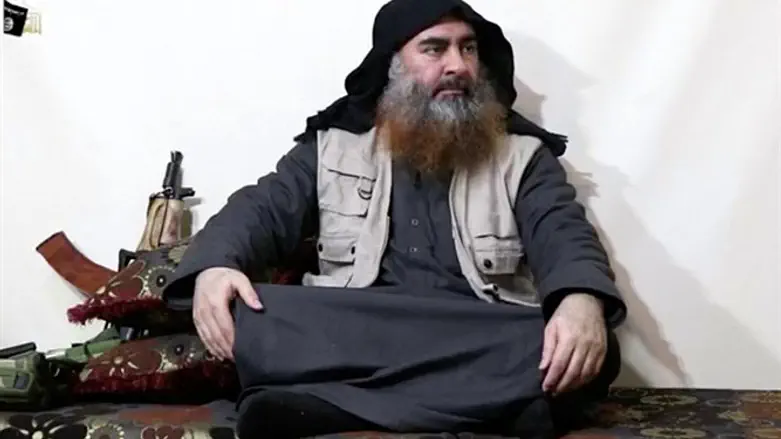
Islamic State’s caliph Abu Bakr al-Baghdadi is dead, US President Donald J. Trump announced during a televised address to the American nation on Sunday morning.
Trump earlier fired off a Tweet in which he announced “something very big had just happened” but the question remains if al-Baghdadi’s death will have big consequences for ISIS and the world.
The American leader claimed the ISIS boss died “like a dog” and as “a coward”.
Al-Baghdadi tried to escape his captors, the US Delta Force, by taking three of his children with him in a tunnel in the vicinity of his hide-out in the Syrian village of Barisha close to the Turkish border.
Once in the tunnel, the most wanted terrorist in the world screamed as dogs pursued him and reportedly detonated a suicide belt which he had strapped to his body, an act captured by cameras and first aired by Iraqi television.
“He died after running into a dead-end tunnel, whimpering and crying and screaming all the way,” Trump told the American nation.
The carefully planned US Special Forces operation was the result of five months of intelligence gathering both by the CIA and the Kurdish-led Syrian Democratic Forces (SDF) which claimed that it had taken part in the daring operation.
“A historic operation is successful as a consequence of joint intelligence work with the United States of America,” Mazloum Abdi, the chief of staff of the SDF, wrote on Twitter.
Local Syrian media and the Syrian Observatory for Human Rights later claimed that 7 or 9 ISIS members died along with al-Baghdad, among them the bodyguard of the founder of Islamic State.
The Delta Force used helicopters to transfer troops to Barisha and then informed the Turkish government about the operation to avoid a confrontation with the Turkish army, which is currently carrying out a new assault on the Kurds in northern Syria.
Apparently the Americans also informed the Russians and Syrian dictator Bashar al-Assad about the night raid in Barisha after which the Iranian regime claimed it had received confirmation of al-Baghdadi’s death.
Observers first were somewhat skeptical about the possibility al-Baghdadi had been killed in Idlib as they pointed to the fact that Hayat Tahrir al-Sham, which today includes the former Al-Qaeda branch Jabhat al-Nusra, controls much of the Idlib Province where Barisha is located.
Apparently the ISIS leader collaborated with the jihadists of Hayat Tahrir al-Sham, however, since local social media activists reported al-Baghdadi could pass through Islamist rebel checkpoints unhindered and with his security detail.
The Delta Force pulled corpses from al-Baghdadi’s destroyed hideout while they also took two living ISIS members with them in their helicopters after the operation ended.
Al-Baghdadi has been reported killed on several occasions, most recently by the Russian army which in 2017 claimed it had killed the ISIS leader near Raqqa, the former capital of Islamic State’s Caliphate.
The ISIS leader rarely appeared in public and the last time he was seen was in April of this year when a video was released of an interview with him by ISIS media outlet Al-Furqan.
In September, the Jihadist organization released an audio statement by al-Baghdadi in which he praised the establishments of new Islamic State provinces in various parts of the world such as Asia and Africa.
Abu Bakr al-Baghdadi was initially a member of Al-Qaeda in Iraq where he joined the organization after ten-months held in custody by the US army in 2004.
After former US President Barack Obama pulled out all American forces from Iraq in December 2011. al-Baghdadi assessed the situation and later founded ISIS, after which he started the war that brought both Syria and Iraq to the brink of disaster and caused a world-wide crisis.
Now that he is dead, the question that remains is what will become of ISIS. Those who claim it will spell the end of the organization are probably wrong.
Al-Baghdadi apparently knew he risked being eliminated and took certain measures which would ensure ISIS’ survival.
First of all, in August he indicated he wanted Islamic scholar Abdullah Qardash to be his successor when he appointed him head of “Muslim affairs” in Islamic State.
Qardash is very popular among ISIS supporters and has a perfect linage since he’s a direct descendant of the Prophet Mohammad’s family, the Quraysh tribe.
He and al-Baghdadi had been comrades since they were imprisoned by the US army in 2004 in the Bucca camp in Iraq.
Al-Baghdadi’s death will most likely also have zero consequences for ISIS’ operational capabilities and in the short term we can expect an uptick in terrorist attacks by the organization’s members across the globe.
"The death of the ‘martyr’ must be avenged" will be ISIS’ motto now and the US should be put on high alert in anticipation of a large terrorist attack.
ISIS is operating in a highly decentralized fashion and this trend has only increased since the demise of the ‘Caliphate’ in Iraq and Syria.
The so-called Wailyahs, the provinces of the Caliphate, can be found across the Middle East, Africa, and in Asian countries such as Afghanistan, Indonesia, Pakistan, the Philippines, and Bangladesh.
The Jihadist organization, furthermore, uses social media and the internet to communicate with its large support base and routinely launches media campaigns to mobilize ‘lone wolves’ and to inspire Islamist groups to become new members of the organization and join the Jihad against ‘infidels’.
The new leadership will no doubt use the way al-Baghdadi died to mobilize ISIS’ groups and members in order to ignite a Jihad against the US, the West and to destabilize regimes in the Middle East.
Israeli Prime Minister Binyamin Netanyahu seemed to warn against over-optimism when he congratulated the US with its “impressive achievement”.
“This is an important milestone, but it’s part of a longer battle which we must win,” Netanyahu cautioned in a statement to the press.
